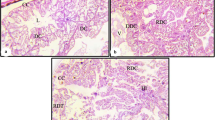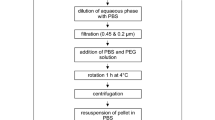Summary
Macerates of bovine brain infected with bovine spongiform encephalopathy (BSE) agent, and rodent brain infected with the 263K or ME7 strains of scrapie agent, were subjected to porous-load autoclaving at temperatures between 134 and 138 °C for ≤ 60 min. Bioassay in rodents showed that none of the regimes produced complete inactivation. Homogenates of BSE-infected bovine brain were exposed for ≤ 120 min to solutions of sodium hypochlorite or sodium dichloroisocyanurate containing ≤ 16,500 ppm available chlorine. There was no detectable survival of infectivity after the hypochlorite treatments but none of the dichloroisocyanurate solutions produced complete inactivation. Homogenates of BSE-infected bovine brain, and rodent brain infected with the 263K and ME7 strains of scrapie agent, were exposed for ≤ 120 min to 1M or 2M sodium hydroxide but no procedure produced complete inactivation of all agents tested.
Similar content being viewed by others
References
Advisory Group on the Management of Patients with Spongiform Encephalopathy (Creutzfeldt-Jakob Disease [CJD]) (1981) Report to the chief medical officers of the Department of Health and Social Security, the Scottish Home and Health Department, and the Welsh Office. London, HMSO, DA(81)22
Asher DC, Pomeroy KL, Murphy L, Rohwer RG, Gibbs CJ, Gajdusek DC (1986) Practical inactivation of scrapie agent on surfaces. Abstracts of the IXth International Congress of Infectious and Parasitic Diseases. Munich 1986
Bernoulli C, Siegfried J, Baumgartner G, Regli F, Rabinowicz T, Gajdusek DC, Gibbs CJ (1977) Danger of accidental person-to-person transmission of Creutzfeldt-Jakob disease by surgery. Lancet i: 478–479
Brown P, Rohwer RG, Gajdusek DC (1986) Newer data on the inactivation of scrapie virus or Creutzfeldt-Jakob disease virus in brain tissue. J Infect Dis 153: 1145–1148
Bruce ME, Chree A, McConnell I, Foster JD, Pearson G, Fraser H (1994) Transmission of bovine spongiform encephalopathy and scrapie to mice: strain variation and the species barrier. Phil Trans Roy Soc 343: 405–411
Carp RI (1992) Scrapie: unconventional infectious agent. In: Specter S, Bendinelli M, Friedman H (eds) Neuropathogenic viruses and immunity. Plenum Press, New York, pp 111–136
Chesebro B (1990) Spongiform encephalopathies: the transmissible agents. In: Fields BN, Knipe DM (eds) Virology. Raven Press, New York, pp 2325–2336
Coates D (1985) A comparison of sodium hypochlorite and sodium dichloroisocyanurate products J Hosp Infect 6: 31–40
DHSS (1984) Management of patients with spongiform encephalopathy [Creutzfeldt-Jakob disease (CJD)]. DHSS Circular 84: 16
Dickinson AG, Fraser H (1969) Modification of the pathogenesis of scrapie in mice by treatment of the agent. Nature 222: 892–893
Dickinson AG, Meikle VMH, Fraser H (1968) Identification of a gene which controls the incubation periods of some strains of scrapie in mice. J Comp Pathol 78: 293–299
Dickinson AG, Taylor DM (1978) Resistance of scrapie agent to decontamination. N Engl J Med 299: 1413–1414
Diringer H, Braig HR (1989) Infectivity of unconventional viruses in dura mater. Lancet i: 439–440
Duffy P, Wolf J, Collins G, DeVoe AG, Streeten B, Cowen D (1974) Possible person-to-person transmission of Creutzfeldt-Jakob disease. New Engl J Med 290: 692–693
Dychdala GR (1977) Chlorine and chlorine compounds. In: Block SB (ed) Disinfection, sterilization, and preservation. Lea & Fabiger, Philadelphia, pp 167–195
Ernst DR, Race RE (1993) Comparative analysis of scrapie agent inactivation. J Virol Methods 41: 193–202
Foncin JF, Gaches J, Cathala F, El Sherif E, Le Beau J (1980) Transmission iatrogene interhumaine possible de maladie de Creutzfeldt-Jakob avec alteinte des grains du cervulet. Rev Neurol 136: 280
Fraser H, Dickinson AG (1968) The sequential development of the brain lesions of scrapie in three strains of mice. J Comp Pathol 78: 301–311
Fraser H, Bruce ME, Chree A, McConnell I, Wells GAJ (1992) Transmission of bovine spongiform encephalopathy and scrapie to mice. J Gen Virol 73: 1891–1897
Gibbs CJ, Gajdusek DC, Asher DM, Alpers MP, Beck E, Daniel PM, Matthews WB (1968) Creutzfeldt-Jakob disease (spongiform encephalopathy): transmission to the chimpanzee. Science 161: 388–389
Gordon WS, Brownlee A, Wilson DR (1940) Studies in louping-ill, tick-borne fever and scrapie. Report of the Proceedings of the Third International Congress for Microbiology. Waverley, Baltimore, pp 362–363
Karber G (1931) Beitrag zur kollectiven Behandlung pharmakologische Reihenversuche. Arch Exp Pathol Pharmacol 162: 480–483
Kimberlin RH, Walker CA, Millson GC, Taylor DM, Robertson PA, Tomlinson AH, Dickinson AG (1983) Disinfection studies with two strains of mouse-passaged scrapie agent. J Neurol Sci 59: 355–369
Mann P (1992) Recreational waters and hydrotherapy pools. In: Russell AD, Hugo WB, Ayliffe GAJ (eds) Disinfection, preservation and sterilization. Blackwell, Oxford, pp 330–332
Pocchiari M Unpublished data cited by Horaud F (1993) Safety of medicinal products: summary. Dev Biol Stand 80: 207–208
Pocchiari M, Peano S, Conz A, Eshkol A, Maillard F, Brown P, Gibbs CJ, Xi YG, Tenham-Fisher E, Macchi G (1991) Combination ultrafiltration and 6M urea treatment of human growth hormone effectively minimizes risk from potential Creutzfeldt-Jakob disease virus contamination. Horm Res 35: 161–166
Prusiner SB, McKinley MP, Bolton DC, Bowman KA, Groth DF, Cochran SP, Hennessey M, Braunfeld MB, Baringer JR, Chatigny MA (1984) Prions: methods for assay, purification, and characterization. In: Maramorosch K, Koprowski H (eds) Methods in virology, vol 8. Academic Press, New York, pp 293–345
Rohwer RG (1984) Virus-like sensitivity of the scrapie agent to heat inactivation. Science 223: 601–602
Rosenberg RN, White CL, Brown P, Gajdusek DC, Volpe JJ, Dyck PJ (1986) Precautions in handling tissues, and other contaminated materials from patients with documented or suspected Creutzfeldt-Jakob disease. Ann Neurol 19: 75–77
Taguchi F, Tamai Y, Uchida K, Kitajima R, Kojima H, Kawaguchi T, Ohtani, Miura S (1991) Proposal for a procedure for complete inactivation of the Creutzfeldt-Jakob disease agent. Arch Virol 119: 297–301
Tamai Y, Taguchi F, Miura S (1988) Inactivation of the Creutzfeldt-Jakob disease agent. Ann Neurol 24: 466–467
Tateishi J, Koga M, Sato Y, Mori S (1980) Properties of the transmissible agent derived from chronic spongiform encephalopathy. Ann Neurol 7: 390–391
Tateishi J, Tashima T, Kitamoto T (1988) Inactivation of the Creutzfeldt-Jakob disease agent. Ann Neurol 24: 466
Taylor DM (1989) Scrapie agent decontamination: implications for bovine spongiform encephalopathy. Vet Rec 124: 291–292
Taylor DM (1990) Inactivation of BSE agent. Dev Biol Stand 75: 97–102
Taylor DM (1992) Inactivation of unconventional agents of the transmissible degenerative encephalopathies. In: Russell AD, Hugo WB, Ayliffe GAJ (eds) Principles and practice of disinfection, preservation and sterilization. Blackwell, Oxford, pp 171–179
Taylor DM (1993) Inactivation of SE agents. Br Med Bull 49: 810–821
Taylor DM (1993) Bovine spongiform encephalopathy and its association with the feeding of ruminant-derived protein. Dev Biol Stand 80: 215–224
Taylor DM, McConnell I (1988) Autoclaving does not decontaminate formol-fixed scrapie tissues. Lancet i: 1463–1464
Wells GAJ, Hancock RD, Cooley WA, Richards MS, Higgins RJ, David GP (1989) Bovine spongiform encephalopathy: diagnostic significance of vacuolar changes in selected nuclei of the medulla oblongata. Vet Rec 125: 521–524
Wight AL (1993) Prevention of iatrogenic transmission of Creutzfeldt-Jakob disease. Lancet i: 1543
Wilesmith JW, Wells GAJ, Cranwell MP, Ryan JBM (1988) Bovine spongiform encephalopathy: epidemiological studies. Vet Rec 123: 638–644
Wilson DR Unpublished data cited by Dickinson AG (1976) Scrapie in sheep and goats. In: Kimberlin RH (ed) Slow virus diseases of animals and man. North-Holland Publishing, Amsterdam, pp 209–241
Author information
Authors and Affiliations
Rights and permissions
About this article
Cite this article
Taylor, D.M., Fraser, H., McConnell, I. et al. Decontamination studies with the agents of bovine spongiform encephalopathy and scrapie. Archives of Virology 139, 313–326 (1994). https://doi.org/10.1007/BF01310794
Received:
Accepted:
Issue Date:
DOI: https://doi.org/10.1007/BF01310794




